BackupChain FTP Server Setup
BackupChain is the only FTP tool on the market that offers all components needed to set up your own remote backup system and thereby save hosting costs. In addition you own and control all computers on the backup network.
This article explains how to set up BackupChain's FTP server, which is included in all BackupChain editions.
Setting Up the FTP Server
The steps required to set up your FTP server using BackupChain have been reduced to a bare minimum; however, these steps do require some basic networking knowledge to complete. Hopefully this tutorial will serve as a guide. You are always welcome to contact BackupChain support with questions and suggestions.
Step #1: Set up BackupChain FTP Server
Click 'FTP Server' and then 'Edit FTP Server Settings' in BackupChain's main menu:
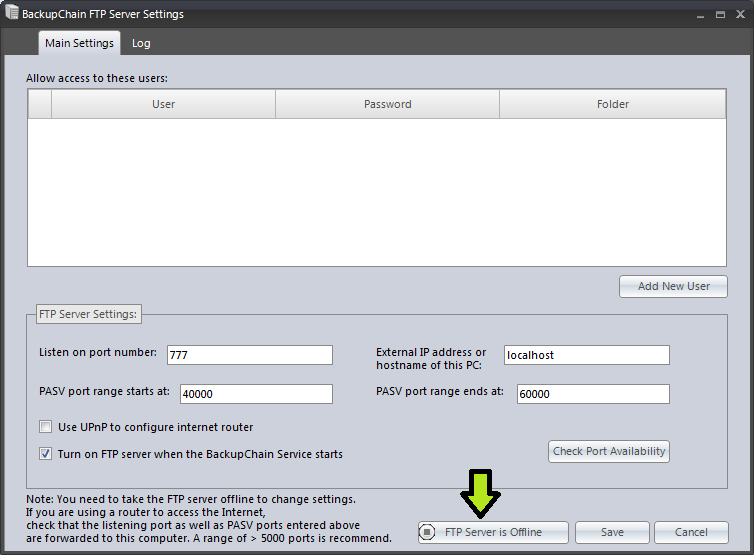
1. Ensure the FTP is server is offline; otherwise, no changes can be made to the FTP server's settings.
2. Select a main port number for the FTP server to listen on. If you are a home user, the FTP standard port 21 may be blocked by your Internet Service Provider, so it's recommended to use a different port. The example above uses port 777.
3. If you have a static IP address, enter it above instead of localhost. If you have a dynamic IP address you can use a dynamic DNS service, such as no-ip.com or dyndns.org to obtain a domain name that will map to your dynamic IP address. At the time of this writing, these dynamic IP services are available for free.
4. PASV port range setup: These are data ports that need to be opened for incoming TCP data traffic. Note that each port can only be used for one connection in three minutes (it's a timeout in Microsoft Windows). If you expect heavy traffic you may want to increase the FTP PASV port range to accommodate more simultaneous FTP users.
5. The UPnP option will configure your home Internet router automatically. However, this only works with fewer than approx. 100 PASV ports on most routers. A manual router setup is recommended for port forwarding (see below).
6. If you click 'Check Port Availability' and have the UPnP option switched on, the system will test if all selected ports are available on your system and your Internet router. Be sure to limit the PASV port range to about 100 ports and select a port range above 1024 as other applications usually occupy ports below 1024. Note: selecting only 100 ports will limit your FTP server's throughput to about 300 files per 3 minutes and is only suited for large file transfer. If you need higher levels of traffic you need configure your Internet router manually, see instructions below.
Add a new FTP User
To add a new FTP user, select 'Add New User' and you receive the following screen:

Ideally, each FTP user should have his/her own data folder; however, FTP users may also share the same folder but this is not recommended. Be sure to enter at least eight characters for the password.
The folder entered above will be storing John's backup files that are received via FTP.
Select OK to add this user and then press Save to save all your settings.
Activating the FTP Server
Bringing the FTP server online is only one click away. Click 'FTP Server is Offline' to activate the server:

If you want to make a change to your settings, you need to stop the server again. Click 'FTP server is online' to stop the FTP server and make your changes. Then save your settings and start the server again.
At this point your FTP server is ready to go! You can try connect to it from our browser using this address: ftp://localhost:777 and log in using the user name and password you have configured earlier.
FTP Server Firewall Configuration
BackupChain adds itself to the Windows Firewall exception list; hence, no further configuration is necessary. If you are using a third-party firewall, however, you need to open the ports you configured for the application C:\Program Files\FastNeuron Inc\BackupChain\FastNeuronBackupChainService.exe. In the above example, you would need to open ports 777 and the entire range 40000 to 60000 and allow incoming TCP traffic to the BackupChain Service executable.
Internet Router Configuration for FTP Servers
Most users will need to configure their router manually because UPnP is not enabled or not sufficient to meet their needs.
The following steps demonstrate how to configure port forwarding for your FTP server. You may be using a different router but the settings should be similar.
Configuring a Verizon Internet Router to work with BackupChain's FTP Server
First, you need to log in to your router. The user name is usually admin and the password should be on the router box itself. Check with Verizon's documentation if you can't find your password to reset it.
Note: Verizon has a rather annoying security feature. As you type the password, the password field appears to be accepting several keystrokes at a time. You can ignore this and keep typing.

After logging in, you will see this screen (or similar):
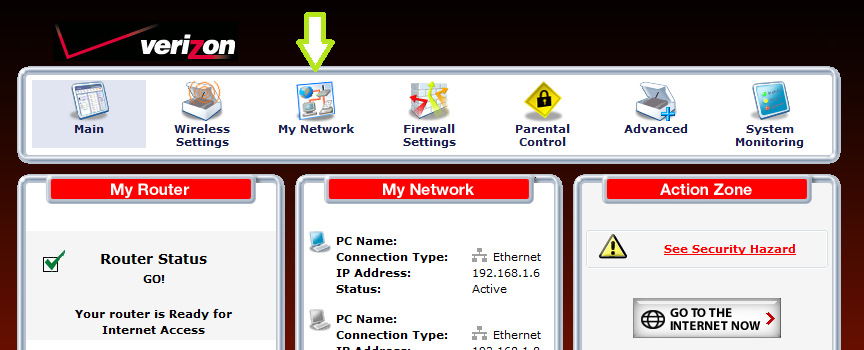
Now select My Network as shown above and you will enter your network's PC list:
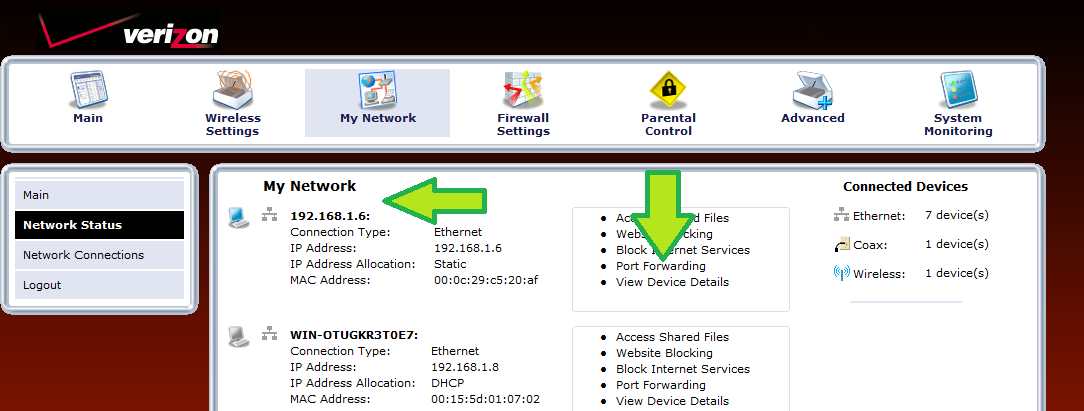
Find the computer running BackupChain FTP Server in the list and click 'Port Forwarding'. In our example, the computer has a static internal IP address 192.168.1.6; otherwise, the computer name will appear instead.
Port Forwarding Configuration for FTP Server Ports
Now you should receive a list of ports that are currently opened for that particular computer you selected:
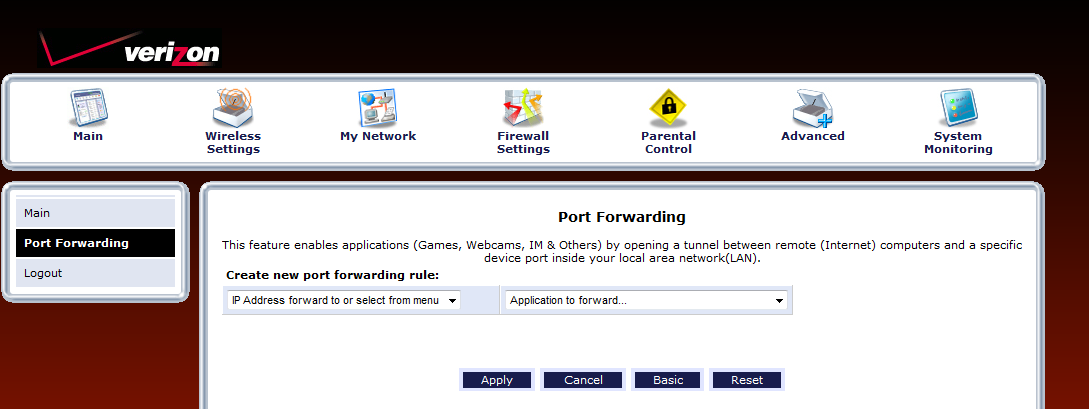
Go through the port list and ensure no ports are mapped that interfere with your PASV port range. In our example above, we want to use ports 777 and the entire range between 40000 and 60000. We need to check whether the list contains these ports already.
If these ports are already in use, you need to find a different port range that still available and re-configure BackupChain's FTP Server.
When you are ready to enter your port numbers, use these settings:

Note: You need to create two forwarding rules. One for the main FTP port 777 and one for the range 40000 to 60000.
First select the computer name or IP address and then select Custom Ports. Specify the TCP protocol and enter your source and destination ports (these will be the identical). The above example uses the port range 8192 to 16384 for BackupChain's FTP Server and forwards them to the internal IP address 192.168.1.8.
Apply the port forwarding rule and the setup is now complete!
Testing your FTP Server and Internet Router Configuration
To test the router configuration and entire setup, you need to use an external computer to connect from outside your network. The simplest thing to try is to use Internet Explorer and enter the address: ftp://<my static IP address or domain name> then log in with the user name and password you configured in BackupChain's FTP Server. The browser should report no errors and show you an empty file list.
Connection Problems
If you experience connection problems, ensure BackupChain has been added as an exception to your Windows Firewall configuration and check your Internet router settings once again.
If you are using a dynamic IP DNS provider, ensure its client program is running and the ping command returns the correct IP address.
Try connecting to BackupChain's FTP Server from the local machine using Internet Explorer and the address ftp://localhost:<port number>
If that works, the problem is most likely the Internet router configuration.
In a business setting, ask your IT administrator to open the incoming TCP ports you configured in BackupChain and forward them to your computer.
Checking the FTP Server Log
The FTP Server log in BackupChain may give you additional information to spot connectivity and/or start-up problems:

Denial of Service Attacks and Server Protection
If you have difficulties logging in to your server, you may have been locked out of BackupChain's FTP Server if you entered a wrong password. BackupChain protects your server by blacklisting a client's IP address for three minutes after a failed login attempt.
In case you are just testing, you may stop and re-start the FTP server to lift the IP ban immediately.
If an external user has problems connecting to an otherwise functioning FTP server system, you may want to check this FTP log to determine if the user connection was accepted and whether the user was banned due to failed login attempts.
Configuration and Router Setup Using Other Routers
In this section we post screenshots of other routers with example configurations for BackupChain's FTP Server:
Linksys Wireless N Gigabit Router WRT310N
To configure a Linksys router, proceed as follows:

The above example maps port external port 7777 to internal port 7777. The PC with internal IP 192.168.1.155 runs BackupChain FTP Server on port 7777. In this case the user chose the PASV ports 20000 to 60000 and configured them as follows:
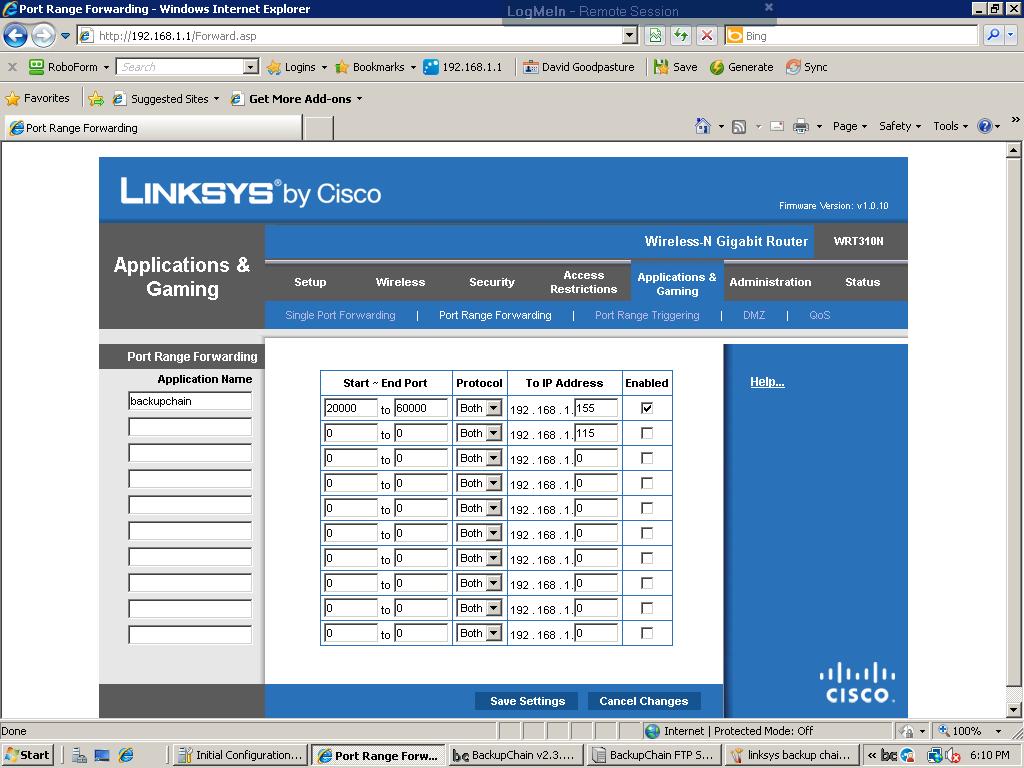
A big thank you to our user David Goodpasture, of Does not Compute, Oklahoma, for providing us these screenshots of his setup.
